Techniques for Successfully Litter Training Your Bunny
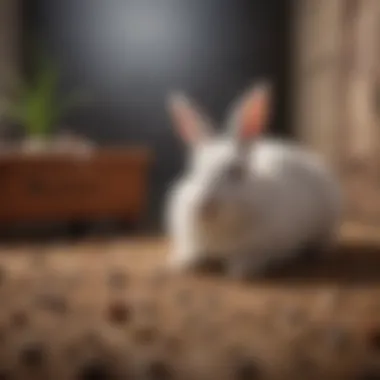
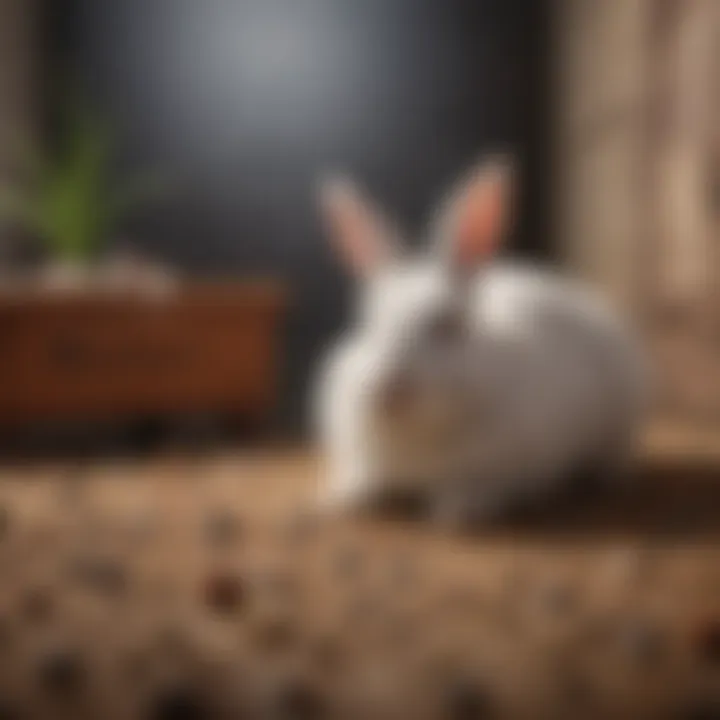
Intro
Litter training a bunny rabbit is not just about convenience; it's about building a deeper relationship with your pet. Understanding how to effectively teach your rabbit to use a designated area can lead to a cleaner living space and a more harmonious home. Rabbits are intelligent creatures with their own unique set of behavioral traits, and tapping into those instincts can make training a rewarding journey for both pet and owner.
In this article, we will delve into the essential techniques for litter training your bunny rabbit, exploring everything from their natural tendencies to the importance of choosing suitable litter. By learning about your pet's behavior and needs, you can create an environment that fosters good habits while keeping your home tidy and odor-free.
In the following sections, we'll discuss the groundwork of understanding your pet, effective training methods, and the best practices for maintenance. Each step we take will be geared towards enhancing your rabbit's quality of life and solidifying the bond you share.
Understanding Your Pet
Pet Behavior Basics
To successfully litter train your bunny, it's crucial to grasp the basics of rabbit behavior. Unlike dogs or cats, rabbits come with their own quirks and instincts. They tend to favor certain spots to relieve themselves, often influenced by their territory and previous experiences. Observing where your bunny naturally goes can give you valuable insight into where to place the litter box.
Common Breed Characteristics
Different breeds of rabbits may exhibit varied behaviors. For example, Holland Lops may be more laid-back, while Netherland Dwarfs could be a bit more rambunctious. These personality traits can influence their willingness to adapt to litter training. Knowing these nuances helps in tailoring the training approach.
Species-Specific Needs
Rabbits are naturally clean animals. They prefer areas that are free from their droppings for both living and playing. This means that when you introduce litter training, it aligns with their instinctual preferences. By setting up a designated litter area that caters to their want for cleanliness, you're one step closer to successful training.
Training and Development
Basic Commands and Skills
While rabbits may not respond to commands like dogs, they can learn through positive reinforcement. Associating the litter box with rewards—be it a favorite treat or gentle praise—can encourage your bunny to use it consistently.
Behavioral Training Techniques
To start the training, place the litter box in a low-traffic spot that your bunny tends to frequent. Use a small amount of hay or their droppings in the box to mark it as their personal space. Don't forget to be patient; rabbits require time to adjust. For some, it may take only a few days, while others might need a week or more.
Addressing Common Behavior Issues
If your bunny strays from using the box, don’t get discouraged. Instead, reassess the situation. It could be due to an unsuitable location for the litter box, an unappealing type of litter, or even stress factors in their environment. Addressing these issues can redirect them back to their training.
"Success in litter training your rabbit lies in understanding their individual behavior and preferences."
Pet Care and Maintenance
Feeding Guidelines
A well-nourished rabbit is more likely to have regular bathroom habits. Ensure they get a balanced diet rich in hay, fresh vegetables, and pellets. This not only supports their digestive health but also regulates their bathroom habits, making the litter training process smoother.
Grooming Essentials
Regular grooming helps prevent fur balls and keeps your bunny's coat in good condition. This can also minimize mess in areas where they usually hang out, contributing to an overall clean environment.
Hygiene Practices
Always maintain cleanliness in the litter area. Scoop out waste daily and replace the litter material as needed. A clean space not only supports litter training but also promotes better health for your bunny.
Health and Wellness
Routine Vet Check-ups
Regular veterinary care is essential for your bunny's overall well-being. It ensures they stay healthy, which directly impacts their litter training success.
Vaccination Needs
Make sure your rabbit is up to date with vaccinations. Certain preventable diseases can hinder your pet’s good health, which in turn could disrupt their training regimen.
Recognizing Signs of Illness
Be vigilant for any signs your bunny might be unwell, such as changes in bathroom habits, lethargy, or hiding behavior. Early detection is key in ensuring their health and keeping the training process on track.
Enrichment and Activities
Indoor vs. Outdoor Activities
Both indoor and outdoor play can be beneficial for your bunny. Engage them with safe spaces and toys to stimulate their mind and keep their little bodies active.
Interactive Toys and Games
Lucky for you, rabbits enjoy interactive toys! These can keep your bunny entertained and also serve as distractions during training. Try offering them chew toys or puzzle games that promote problem-solving skills.
Socialization Opportunities
Lastly, don't forget to socialize your bunny. Visiting friends or allowing gentle interactions with other pets can enrich their lives, ultimately contributing to a happier and more well-adjusted rabbit.


By understanding your bunny's needs and habits, you can set the foundation for effective litter training. With patience, care, and the right techniques, you can ensure both you and your furry friend have a clean, happy living space.
Understanding Bunny Behavior
Understanding the behavior of your bunny rabbit is critical when embarking on the adventure of litter training. Rabbits may not express themselves like dogs or cats, yet their instincts and actions carry significant insights into their psyche. This knowledge can turn a potentially challenging task into a rewarding journey for both you and your pet. Recognizing what makes your bunny tick will be the foundation upon which effective training builds.
Natural Instincts of Rabbits
Rabbits are prey animals, which shapes their habits and instincts. One essential instinct to know about is their tendency to regularly mark their territory. In the wild, they do this to convey information to other rabbits while maintaining hygiene. This natural inclination to designate a specific area as their bathroom can be quite advantageous for training purposes.
When you observe your bunny, pay close attention to the places they already gravitate towards for their business. Often, they prefer corners or certain spots within their living area. By recognizing these tendencies, you can capitalize on their natural behaviors, making it easier for your rabbit to adapt to a litter box setup. This proactive approach is helpful because it reduces stress for both pet and owner, explaining why it’s important to tune into their natural instincts.
Common Traits Affecting Litter Training
To enhance your litter training success, consider various common traits in rabbits, which can impact the process. For starters, each rabbit has a unique personality. Some may be more laid-back, while others display more energetic or skittish behavior. This can influence how receptive they are to training. A calm rabbit might adapt well to a litter box, but a nervous one may require extra patience and gentleness.
Additionally, age is another factor. Young bunnies are still learning about their environment and behavior. On the flip side, older rabbits tend to be set in their ways, which might make them resistant to change. The key takeaway here is to assess your rabbit's specific traits and behaviors. By adapting your training strategies based on these characteristics, the entire litter training process can feel smoother and more intuitive.
"Rabbits are creatures of habit; understanding these habits will pave the way for successful litter training."
In summary, the insights gained from understanding bunny behavior not only empower you as a pet owner but also foster a meaningful relationship between you and your furry friend. With the right knowledge and approach, litter training becomes less of a chore and more of an enjoyable endeavor.
Choosing the Right Environment
Creating a suitable environment for your bunny can make all the difference in the litter training process. It’s not just about having a confined space where the rabbit hangs out; it’s about encouraging their natural tendencies and making them feel at ease. A thoughtfully arranged space increases the chances of success and contributes to a happier, more confident pet.
Having a designated area serves two main purposes: it provides a sense of stability for your bunny and helps control where they choose to relieve themselves. Bunnies instinctively prefer to go to the bathroom in specific corners, so offering them a defined spot is key. Understand that rabbits have their idiosyncrasies, and a little bit of observation can go a long way.
Ensuring comfort in their environment cannot be overlooked. A cozy space filled with familiar scents and soft bedding creates a safe haven for your bunny. Adequate lighting, temperature control, and noise levels all contribute to their overall well-being. If they feel relaxed, the road to establishing good litter habits becomes smoother. Here’s a closer look at how to set the stage:
Designating a Specific Area
Identifying a specific area for your rabbit is crucial. Many rabbits will instinctively gravitate toward a particular corner of their space. This trait can be harnessed to guide them towards understanding where it’s appropriate to do their business.
- Choosing the Right Corner: Observe your rabbit’s behavior. Often, they’ll favor one spot for relieve activities. Position a litter box there to steer them in the right direction.
- Avoiding High Traffic Places: Make sure the area you choose is quiet and not subject to frequent interruptions. An undisturbed environment helps bunnies relax and makes them feel secure.
- Adding Familiar Elements: Include some of their favorite toys or bedding to create a sense of familiarity and warmth in that area.
Creating a Comfortable Space
The environment where your bunny spends their time needs to promote comfort and security. The more at ease they are, the easier the litter training will be.
- Soft Bedding: Use gentle materials such as hay or recycled paper products in the litter box. These options are not just comfortable but also safe for your bunny to nibble on, should they choose to do so.
- Temperature Matters: Keep the space well-ventilated and at a comfortable temperature. Bunnies are sensitive creatures; too hot or cold can stress them out, which could hinder their training progress.
- Minimize Distractions: Reduce loud noises and potential disturbances. Place their area away from bustling paths in your home.
- Routine: Keep their space routine the same. Changes can disrupt their comfort zone. Sticking to a familiar layout makes it easier for your bunny to find their feet – and their litter box.
"A well-thought-out environment paves the way for successful training and happier bunnies. Trust your instincts and adapt based on your pet's preferences."
In summary, an environment that reflects your bunny’s natural instincts and provides comfort is crucial. It sets the foundation for successful litter training while fostering a positive relationship between you and your furry friend.
Selecting Appropriate Litter Materials
When it comes to litter training your bunny rabbit, the choice of litter materials plays a pivotal role in ensuring both comfort and effectiveness. Not only does the right litter help facilitate the training process, but it also contributes to the health and happiness of your pet. The purpose of selecting the right litter is twofold: ensuring your rabbit's safety while promoting positive bathroom habits.
Types of Litter Available
There is a variety of litter options available on the market, each with its own unique properties.
- Paper-Based Litter: This is an excellent choice for bunnies, as it is absorbent and often dust-free. Look for brands that specifically mention they are safe for small animals.
- Wood Shavings: Pine and aspen shavings are common, but steer clear of cedar, as it can be harmful to rabbits. Wood shavings control odors well, but they might not be the most absorbent option.
- Pellet Litter: Made from compressed sawdust or paper, this litter is designed to absorb moisture effectively. It's also easy to clean up but might be less comfortable for a bunny used to softer materials.
- Corn-Based Litter: This biodegradable option has the added benefit of being flushable in some cases. It does a reasonably good job at odor control and is often favored by eco-conscious pet owners.
In summary, choosing the right litter isn't just a matter of convenience; it's about creating a safe and inviting space for your bunny.
Safety Considerations for Rabbits
Safety should always be at the forefront of your mind when selecting litter materials. Here are several important factors to keep in mind:
- Non-Toxic Materials: Always verify that the litter is labeled as non-toxic. Some materials might contain additives that can harm your rabbit if ingested.
- Dust-Free Options: Rabbits have sensitive respiratory systems. Opting for dust-free litters minimizes the risk of respiratory issues, ensuring your bunny can breathe easy.
- Avoid Synthetic Fragrances: While it may be tempting to choose scented litters, these can be overwhelming and harmful to rabbits. Stick to natural options that won't irritate their delicate noses.
"Choosing the right litter can make all the difference in creating a comfortable environment for your bunny. Prioritize safety above all."
By paying attention to these safety considerations, you're well on your way to establishing a hygienic and enticing litter area that will promote good habits in your bunny. An informed selection is the best way to foster a joyful and stress-free living space for your beloved pet.
The Litter Training Process
The litter training process acts as a cornerstone for establishing a harmonious living environment for both the rabbit and the owner. It not only helps maintain cleanliness but also nurtures the bond between pet and human. For bunny rabbits, finding the right spot to do their business is almost instinctual; however, guiding them to a designated area requires patience and understanding. By effectively managing this process, pet owners can significantly reduce the mess and make their furry friends feel secure and at home.
Establishing a Routine
Establishing a routine is fundamental in litter training. Consistency is key when teaching your bunny where to relieve itself. Try breaking your day into specific intervals where you can take the time to observe your pet's habits. Rabbits tend to have predictable patterns, often going after meals or after playtime. By noticing these habits, you can create a feeding and bathroom schedule that suits your bunny's natural rhythms.
- Timing: Set a feeding schedule. Feed your bunny at the same time each day; this can help predict when they need to use the litter box. After meals, they usually need to relieve themselves.
- Location: Always take them to the same spot after a meal or when you observe they need to go. They’ll learn to associate that area with their bathroom needs.
- Repetition: Don’t be shy about repeating this process daily. The more familiar they are with the routine, the better their understanding of where they're welcome to go.
Encouraging Desired Behavior
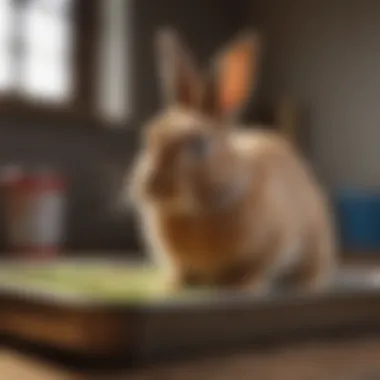
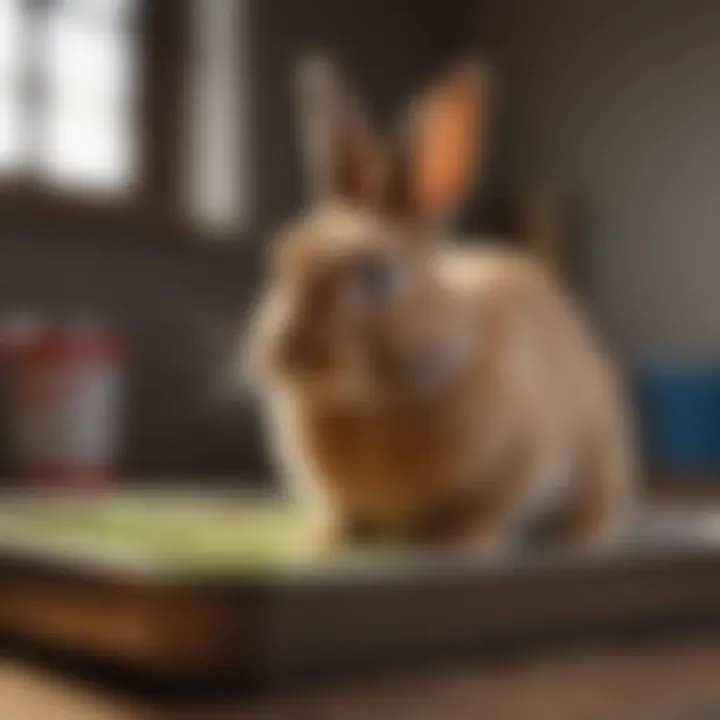
With any training, positive reinforcement goes a long way. Encourage your bunny when they use the designated area. This could be in the form of gentle praise or small treats. Rabbits respond far better to encouragement than to scolding. If your bunny approaches the litter box, give them a chance, and if they use it, celebrate that success.
- Verbal Praise: Simple words of encouragement like "Good bunny!" can make a difference. Your tone of voice will convey your approval.
- Favorite Treats: Keep their favorite snacks handy. After they use the litter box correctly, offer a small piece as a reward. It reinforces that using the litter box is a positive action.
Keep an eye on missed opportunities too. If they do go outside of the litter area, simply clean it up without making a fuss. This absence of attention reduces the chance of them repeating unwanted behavior. Over time, they’ll grasp that particular areas are for relief.
Adjusting Techniques as Needed
Training can be an evolving process. Every bunny is unique, and what works for one might not work for another. If you start to notice that your rabbit isn’t responding well to your training techniques, it may be time to rethink your approach.
- Observe Behavior: If a particular strategy doesn’t seem effective, take a step back and watch your bunny’s habits more closely. Are they avoiding the litter box? Maybe it’s not spacious enough or the material inside is unappealing.
- Experiment with Different Litter: Sometimes, it’s a matter of comfort. If your bunny refuses to use the litter box, consider changing the litter type, ensuring it’s a texture they prefer.
- Modify Location: You may need to relocate the litter box or add several boxes in different areas. Some rabbits might prefer more options.
Adapting your techniques doesn’t mean you've failed but rather that you're tuning into your pet's needs. This responsiveness enriches your relationship and fosters a more comfortable living space for your bunny.
"Patience is the companion of wisdom."
In the end, the litter training process involves a good mix of observation, encouragement, and adaptability. Through consistent routines, rewarding successes, and adjusting techniques, you pave the way for a seamless transition into a clean and happy home for your bunny.
Monitoring Progress and Adjustments
Monitoring your bunny's progress during litter training is crucial to ensuring that the process is beneficial for both you and your pet. It allows you to assess whether the training techniques you are using are having the desired effect. Keeping an eye on your rabbit's behaviors and responses not only highlights what aspects of the training are successful but also illuminates areas that may require a different approach. This constant evaluation ensures that the training remains effective and can adapt to your bunny’s evolving needs, resulting in a more harmonious living environment.
Recognizing Success in Litter Training
Success in litter training can be identified through several key indicators. One of the most reassuring signs is when your bunny consistently uses the designated litter area. Over time, you might notice fewer accidents elsewhere in their living space, which speaks volumes about their understanding of where to go.
Adapting to the specific behaviors of your bunny can also help gauge success. For instance, if your rabbit begins to naturally seek out their litter box after eating or waking from a nap, that’s a big win. Remember, patience is essential here; even small successes merit acknowledgement. When you spot these signs, rewarding your rabbit with a treat can strengthen this positive behavior.
Identifying Challenges
As with any training, there are bound to be bumps along the way. It's important to recognize challenges early to address them effectively. One common issue is when a rabbit repeatedly uses areas outside the litter box. Sometimes, this behavior indicates a need for a change in your approach.
Another challenge might arise from the type of litter used. If your bunny seems hesitant to use the box, consider whether the material is off-putting to them. The wrong texture or scent can deter even the most willing rabbits. Keeping an open line of communication with your pet — through observation and experimentation — can spark new strategies.
Some common challenges include:
- Unfamiliarity with the litter box: New environments can confuse rabbits.
- Medical issues: If accidents seem sudden and frequent, consult a vet to rule out health concerns.
- Territorial behavior: A spayed or neutered rabbit is more likely to accept litter training.
Revising Training Techniques
When the initial techniques do not yield results, don’t hesitate to revise your strategy. This might involve adjusting the layout of their space or changing the type of litter used. It could also mean refining your schedule to be more consistent with your bunny's natural habits.
For example, if your rabbit is more active at certain times of day, try to prompt them towards the litter box then. Consistency is key — the more you align your actions with their routine, the smoother the training will go.
Incorporating different teaching methods, like gently placing the bunny in the litter box when they show signs of needing to go, is useful too. No one method fits all situations. Observe, adjust, and be willing to re-evaluate your approach, and you'll likely notice significant improvements in your bunny's litter training journey.
"Every rabbit is as unique as its owner; adaptability is the name of the game."
Monitoring is an ongoing process that enriches the training experience for both you and your pet. It transforms litter training from a mere task into a rewarding journey towards building a clean and loving space for your bunny.
Maintaining a Clean Living Area
Keeping your bunny’s living space clean is not just about aesthetics; it plays a crucial role in your rabbit's health and happiness. Rabbits are naturally inclined to be clean animals, often designating specific areas for their bathroom habits. However, it falls upon you, the owner, to ensure that these designated areas are kept tidy. A clean home contributes to an environment where your rabbit can thrive, minimizing unpleasant odors and potential health hazards.
An inviting and hygienic space can also foster better litter training success. When rabbits have a clean litter box, they are more likely to use it diligently. Moreover, regular cleaning prevents the buildup of bacteria and parasites that can lead to illness. Unlike cats, rabbits do not cover their waste, which means it's up to you to ensure that their areas remain free of mess.
Daily Cleaning Practices
Daily maintenance of your rabbit's litter area doesn’t have to be a Herculean task. A few simple yet effective practices can go a long way:
- Spot cleaning: Every day, check the litter box for waste and soiled bedding and remove it promptly. This helps create a fresh environment.
- Refresh bedding: Replace the litter and bedding materials at least once a week, or more frequently if you notice odors or soggy areas.
- Wipe surfaces: Use a damp cloth to wipe down areas around the cage to remove any spillages or remnants.
- Check corners: Sometimes, rabbits have favorite spots outside of the litter box. Ensure you tidy up these areas as well to discourage bad habits.
Implementing these daily cleaning habits not only helps in keeping the environment clean but strengthens the bond between you and your pet by showing that you’re attentive to their needs.
Dealing with Odors
Odor control is another critical aspect of maintaining a clean living area. While rabbits are generally tidy, neglecting waste management can lead to an unpleasant smell that permeates their surroundings. Here are some strategies to effectively manage odors:
- Choose the right litter: Opt for absorbent and natural materials like paper-based litter instead of clay or wood shavings that might retain smells.
- Use odor-absorbing additives: Some rabbit owners swear by baking soda added to the litter to help neutralize odors. Just sprinkle a light layer in the box before adding the litter to enhance its effectiveness.
- Ventilation: Ensure proper airflow in your pet's space. Position the cage or litter box in a well-ventilated area to help dissipate smells.
- Regular deep cleaning: At least once a month, perform a deep clean of the entire area by removing everything from the cage, scrubbing surfaces, and allowing them to dry completely before putting everything back in.
Keeping a clean environment isn’t just pleasure for the nose; it’s vital for your bunny's overall well-being.
By maintaining a routine of daily cleaning practices and being proactive about odor control, you’ll be creating a happy, healthy habitat for your bunny, supporting their natural tendencies and encouraging successful litter training.
Behavioral Reinforcement Techniques
Training a bunny to use a litter box can be a rewarding experience, but understand that it involves some behavioral reinforcement techniques. These methods are essential as they help solidify desired habits in a non-coercive and effective manner. By using behavioral reinforcement, you encourage your rabbit to associate good behaviors with positive outcomes, ensuring they feel comfortable and secure in their new routine.
Using reinforcement builds a bridge of trust between you and your pet. It's about making the litter training process a shared experience rather than a chore. Addressing some specific elements of this approach can enhance the effectiveness of your training efforts:
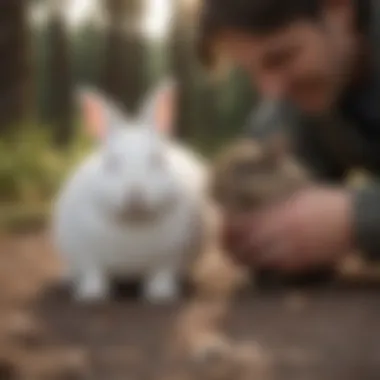
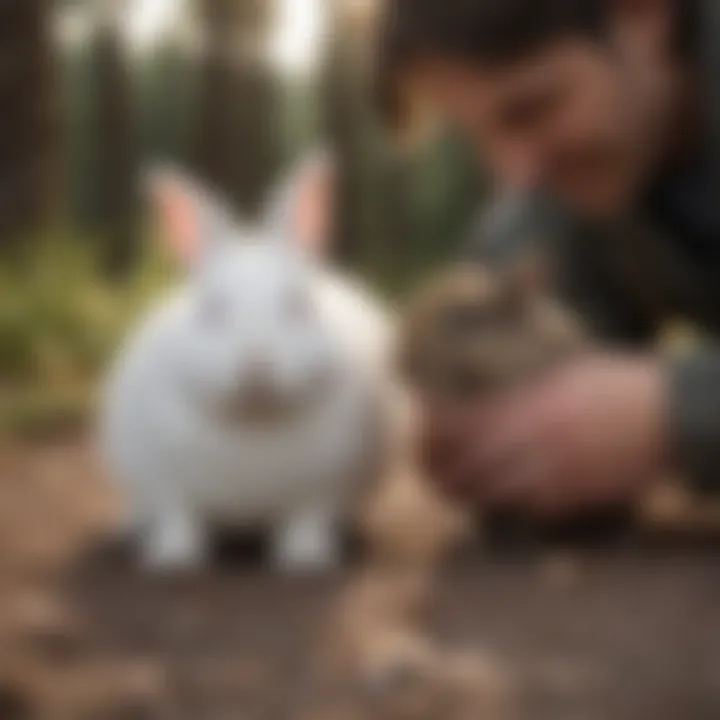
- Build Positive Associations: Every time your bunny uses the litter box correctly, reward them with a treat. This not only reinforces the behavior but also encourages them to engage in it more often.
- Consistency is Key: Make sure everyone in your household uses the same cues and rewards. Inconsistencies can confuse your bunny, derailing their training progress.
- Patience and Timing: It's crucial to offer praise or rewards immediately after the desired behavior. This helps your rabbit make connections between their action and the positive outcome.
"Reinforcement is not just about treats. Sometimes, your bunny may just want affection or gentle words of encouragement."
When thinking about behavioral reinforcement, keep in mind that the approach should always feel like a fun interaction rather than a performance or an obligation. Maintaining this perspective can lead to a smoother training journey.
Positive Reinforcement Methodologies
Positive reinforcement methodologies primarily focus on rewarding good behavior as a means of encouraging it. For instance, treats like diced carrots or small bits of apple can work wonders when your bunny makes a trip to the litter box. Here are some practical strategies:
- Timing and Repetition: When your bunny uses the litter box, give them a treat right away. Timing is important here. The more consistent you are, the more effective the reward system becomes.
- Clicker Training: Some pet owners find success with clicker training. You can use a clicker to mark the moment your bunny does the right thing, followed by a treat. This can help instill a clear understanding of what behavior is desired.
- Verbal Praise: Along with treats, use a happy tone or soothing words of praise. Your bunny may not understand what the words mean, but the emotion behind your tone is unmistakable.
Recognizing Emotional Responses
Understanding your bunny's emotional responses can significantly improve the training process. Rabbits are sensitive creatures, and recognizing their feelings plays a big role in effective communication. Here are some insights:
- Body Language Matters: Observe your rabbit's posture and movements. For example, if they seem relaxed and flop down, it’s a sign they feel secure. Conversely, a crouched body or thumping indicates stress or discomfort.
- Curiosity is Key: A rabbit's inquisitive nature often leads them to explore their surroundings. If your bunny shows curiosity towards the litter box, that’s a green light. It suggests they are open and ready to learn.
- Taking Breaks: If you notice signs of frustration or indifference, give your bunny a break. Sometimes, too much pressure can backfire. Allow them time to adapt to their routine at their pace.
In summary, establishing behavioral reinforcement through positive methods and understanding emotional responses creates a nurturing environment for your pet. Both of these techniques not only facilitate successful litter training but also enrich the bond between you and your furry friend.
Common Mistakes to Avoid
Litter training a bunny rabbit might seem like a straightforward task, but there are several common pitfalls that can hinder success. Recognizing and understanding these mistakes is pivotal to smooth training. Pet owners often unknowingly set themselves up for challenges, not realizing that their methods can cause confusion for their furry friends. Understanding these missteps can lead to a more harmonious relationship between pet and owner, ensuring that the bunny feels secure in its environment while reinforcing good behaviors.
Inconsistent Training Approaches
One of the primary errors in litter training is inconsistency. Just like any living creature, rabbits thrive on routine. If you’re shifting from one method to another or even varying the commands you use, it can muddle things for your bunny. For instance, you might find yourself saying "go potty" one day, and then merely pointing at the litter box the next. This inconsistency raises questions in your rabbit’s mind.
Some key points regarding this misstep include:
- Routine is Key: Set a training schedule and stick to it. This consistency helps your bunny develop habits that can endure.
- Clear Commands: Pick simple phrases and stick with them. Avoid switching between commands like and make sure everyone in the household uses the same language.
- Litter Box Location: If you keep moving the litter box around, your rabbit might feel lost. Pick a location and stick to it unless it’s absolutely necessary to change.
"Consistency breeds confidence in your rabbit, allowing for a smoother litter training experience."
Neglecting Rabbit Behavior Patterns
Another significant oversight is failing to pay attention to natural rabbit behaviors. Understanding these behaviors is crucial for effective training. Rabbits have instincts that dictate where they want to relieve themselves. Many times, owners may overlook the signs of where their bunny prefers to use the bathroom.
Consider the following:
- Territorial Marking: Rabbits often mark their territory in certain areas. Take note of these spots and stick a litter box nearby. This can lead the bunny to associate the box with the urge to go.
- Observation is Critical: Spend time watching your bunny. Are there particular spots it frequents? These behaviors should not be ignored.
- Reinforce Positive Behavior: When your bunny uses the litter box, positive reinforcement is vital. A simple treat can encourage more good behavior without confusing your rabbit.
Taking time to adjust your training approach and pay attention to your bunny's natural tendencies can make all the difference. Avoiding these simple yet impactful mistakes can yield a much more successful litter training experience.
Resources and Support
When it comes to litter training your bunny rabbit, having access to the right resources and support is crucial. Training a pet is more than just a task—it's a journey that comes with its share of challenges and rewards. Proper support can ensure that both the owner and the rabbit navigate this process smoothly, leading to a more harmonious living situation. This section will look into two vital aspects: seeking professional help and engaging with community forums.
Finding Professional Help
Engaging with professionals can make a world of difference in the litter training journey. Experts such as veterinarians with experience in small animal care or certified animal behaviorists can offer valuable insights. They're equipped with knowledge about common behavioral issues that might be affecting your rabbit's litter training progress. For instance, if your bunny is neither using the litter box nor showing any inclination to adapt, a professional can help identify if it's more than a training issue – perhaps a health problem.
Visiting a vet who specializes in rabbits can also provide guidance on the health implications associated with improper litter habits.
Some possible points to consider:
- Access to tailored advice based on the specific breed or personality of your rabbit.
- Understanding underlying health conditions that could impact behavior.
- Recommendations for litter materials that may suit your bunny better.
- Structured training plans or timelines.
Establishing a rapport with a professional can help you feel supported throughout your training process. After all, having someone experienced in your corner can ease many uncertainties and boost your training confidence.
Community Forums and Advice
The pet owner community can be a goldmine when it comes to shared experiences and advice on litter training. Platforms like Reddit or Facebook offer specialized groups where bunny owners congregate to chat and share insights. The collective wisdom in these forums can be incredibly beneficial.
Some top benefits of engaging in community forums include:
- Real-World Experiences: Many forum members will share their successes and failures. This firsthand knowledge can be immensely helpful and relatable, showing you that you’re not alone in facing challenges.
- Diverse Techniques: Different owners may have tried various techniques and solutions. You can gather a variety of strategies to see what might work best for your bunny.
- Emotional Support: Sometimes, just knowing that others are in the same boat can provide emotional relief. Engaging with other members can inspire confidence and motivation to persist in your training efforts.
If you're keen to dive into such communities, consider looking up groups and threads specifically tailored to rabbit training:
Community connections can unveil insights that textbooks simply cannot.
Utilizing these resources and support systems can greatly ease the path to successful litter training, allowing pet owners to craft a positive and effective training routine for their beloved rabbits.
Finale and Final Thoughts
In wrapping up our exploration of litter training your bunny rabbit, it's crucial to emphasize the journey itself rather than just the end goal. Training is more than a chore; it’s a bonding experience that can significantly improve your pet's quality of life and the harmony within your home. Not only do you contribute to the well-being of your rabbit by providing a clean, comfortable environment, but you also foster a sense of trust and companionship as you work together through this process.
Reflecting on the Litter Training Journey
Reflecting on the litter training journey involves acknowledging both the highs and the lows. Every rabbit is unique, and understanding that the training might have its quirkiness is part of the adventure. Here are some key points to consider:
- Emotional Resilience: Just like people, rabbits have good and bad days. You might find that certain days yield more accidents than others. Patience and resilience during these times are vital.
- Consistency is Key: As you've probably come to learn, a consistent approach to training can yield significant benefits. Regularly taking your bunny to their designated area reinforces their behavior. It's a habit worth cultivating, not just for them but for yourself too.
- Celebrate the Small Wins: Every success, no matter how tiny, should be celebrated. Whether it’s using the litter box once or consistently for a week, these small victories help build momentum and reinforce both your bunny’s progress and your motivation.
- Learning Together: Litter training can teach you a lot about your rabbit’s behavior and preferences. Observing how they respond to different litter materials or environments helps you adapt your strategy effectively.
- Realistic Expectations: Remember that it may take some time before your bunny consistently uses their litter box. Adapt your plans according to their progress and individual personality.







